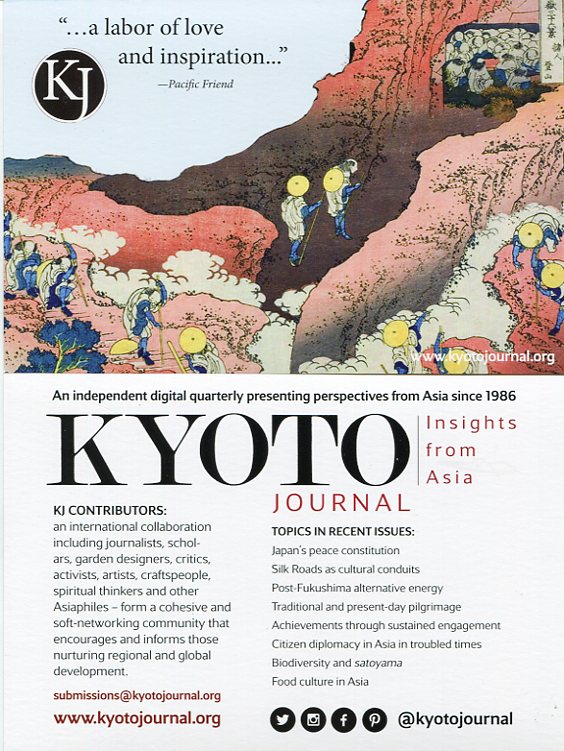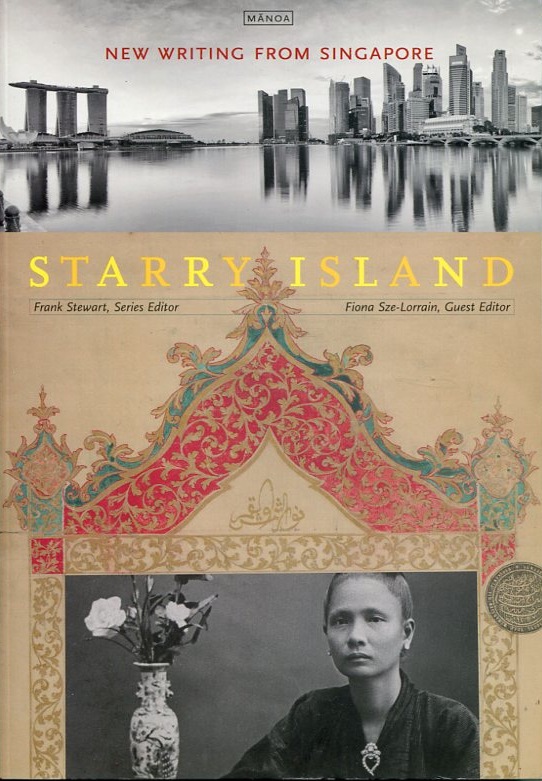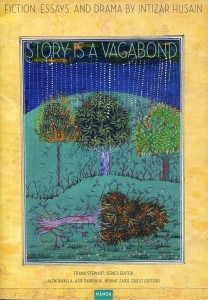
(From Ken Rodgers, KJ Managing Editor)
KJ 86, a Work in Progress…
Back when Kyoto Journal was a print publication, I used to describe it as the only quarterly that came out three times a year — and in these days of virtually instant digital publishing we still prioritize content over deadlines, and allow time for each issue to achieve critical mass. Each article is painstakingly prepared in collaboration with the author, and designed with unique style; we don’t rely on any one-size-fits-all templates. And since everyone involved in the process works on a voluntary basis, fitting KJ into their otherwise busy schedule, everything does take time. So yes, as usual our next issue is rapidly approaching due date, and is still in the layout stage, but here’s a rundown on what we’re looking forward to releasing:
Trevor Carolan interviews eminent poet and essayist Gary Snyder, now in his 86th year, about his latest book; “celebrity photographer” Russell Wong bids farewell to Tokyo’s iconic Hotel Okura; Egyptian poet Yahia Labadibi re-engages with the ancient art of aphorism; translator Cathy Hirano talks about translating children’s fiction (including Nahoko Uehashi’s popular Moribito series); David Billa shares insights into the current 2016 twelve-island Setouchi Triennale; Bill Clements profiles Dr. Nagai Takashi, author of The Bells of Nagasaki; Lucinda Cowing interviews Singapore-based designers Francesca Lanzavecchia and Hunn Wai of Lanzavecchia + Wai, and Robert Fouser discovers a Japanese art renaissance in New York. Pedro Medeiros is one of only two photographers authorized to shoot Kyoto’s firelight Takigi Noh, for the first in a series of special articles on Noh by Toyoshima Mizuho; Elle Murrell interviews the founders of Miksang meditative photography, and Margaret Chula and Michael Dylan Welch meditate on haiku. Plus fiction from Taeyin ChoGlueck, and as always, much more…
KJ 86 is expected in late July, to be announced on our website and on KJ Facebook.
Meanwhile, here’s a preview review, in which I introduce our favorite publication. As far as I know, it always succeeds in coming out perfectly on time:
Sparking Illuminations

Manoa is a journal that’s much more than a magazine: every issue is an exuberantly oversized paperback slab of a book, packed with dazzlingly illuminative writings. Editors Frank Stewart and Pat Matsueda succeed brilliantly in providing curated insights, with the astute assistance of local guest editors and skilled translators, into non-Western (mostly Asian/Pacific) literature—and a welcome cultural antidote to the tropes of more familiar English-language publishing (see interview, “Revealing the Invisible” on KJ’s website).
The very notable recent Starry Island, New Writing from Singapore (Manoa 26-2), guest-edited by Fiona Sze-Lorrain, showcases 30 delightfully contemporary writers from that “anomalous, confounding, and paradoxical society”—exploring unexpected interplays between past and present, particularly the vast environmental and social changes that have occurred through the island’s transition from its tiger-hunting colonial era to the concrete jungle of today’s sci-fi animatronic Asian Tiger financial hub, on the 50th anniversary of its separation from its short-lived union with the Federation of Malaysia. A valuable and eye-opening introduction to “Sing Lit,” this anthology is a party, a phantasmagorical post-modern salon which readers are privileged to gatecrash and to savor the sparkling conflagration of chance encounters that ensues among these authoritative authors. (Incidentally, a poem by featured writer Jerrold Yam, ‘Teahouse,’ appeared in KJ 84).
26. Things Out of Place
A flute in a trumpet case. Red wine on white linen. Sprays of heath in a blue bucket outside a Korean deli. A cheeky boy among mourners at a wake. A beautiful man married to a woman. A Singaporean in New York. The Singaporean in Singapore. The moon in a lake.32. All Things
All things diminish as they grow older, a friend of many years said last week. Even the expanding universe must contract. This morning, as I am boiling water to make coffee, his words come back to me, as sure as before, but smaller, because the whistling of the kettle takes up space. The steam was not so long ago a patch of snow. Love is what life boils into.
(From The Pillow Book — Jee Leong Koh)

Story is a Vagabond (Manoa 27:1), guest-edited by Alok Bhalla, Asif Farrukhi, and Nishat Zaidi, is a timely collection of fiction, essays and drama by Intizar Husain, a leading Urdu writer from Uttar Pradesh who migrated (with some reluctance, it seems) to Lahore, Pakistan, at the time of Partition. While present-day Pakistan is notorious for fundamentalist cultural death squads, nationalist fanaticism and gender-gap extremism, Husain’s stories reach back to a deeper tradition of tolerance and mutual respect, within a literary history of shared sources, where vagabond tales passed between Muslim, Hindu and Buddhist societies in spiritual coexistence and even interdependence. Drawing upon sources “as diverse as the Panchtantra, Jataka Katha, Katha Sarit Sagara, Mahabharata and the Vedas,” and depicting characters who are often bewildered, dislocated and dispossessed, he consistently reveals, without resorting to polemics, the impact of losing the cultural diversity that so enriched pre-Partition India. In ‘Many Dreams Later’ he poignantly tells of a journey made late in his life, to revisit his childhood home—in a way that resonates perfectly with his fiction, he finds that it has changed irrevocably, beyond recognition. Intizar Husain died in February this year, in his early nineties, not long after this collection was published, leaving, most regrettably, no known literary heirs.
…Mahatma Buddha is a pure storyteller. He doesn’t use the stories to preach. His sermons are distinct. When he preaches, he preaches. When he tells a story, he’s a storyteller. There’s no confusion between the storyteller and the preacher. If some moral lesson emerges from the story, it is purely incidental. Mahatma Buddha is only telling a story from his previous birth, which in itself is a good story…
For example, there is the Jataka in which Mahatma Buddha is born as a king. The king has a daughter who is in love with a young man from her own family. She either elopes with him or is kidnapped by him. It is a matter of deep concern.
At the end of the Buddha’s story, the bhikshus say, “It is strange for a king’s daughter to elope or be kidnapped.”
“Do you know who that king was? It was I.”
“It was you, Tathagata? It was your daughter who eloped with someone? What happened next?”
“Nothing. I gently called both of them back. Got them married. Handed over the kingdom to them. Then I gave up that life, was reborn as a partridge, and flew away.”
I feel as if Mahatma Buddha is telling the story especially to me. As if he’s asking me, What is this nonsense about honour killings in your country? Look at how I solved the problem.
(From ‘The Reason and Purpose of the Jataka Stories’; translation by Nisaht Zaidi and Alok Bhalla).
The series’ most recent issue, The Colors of Dawn: Twentieth-Century Korean Poetry (Manoa 27-2), was guest-edited by translator Brother Anthony of Taizé (another KJ contributor) and Chung Eun-Gwi. It’s essentially a reasoned catalog of the (mostly male) modern poets of South Korea, set against the tumultuous changes that have wrenched the country’s psyche since 1910, including annexation by Japan, the Korean War, postwar dictatorships, the struggle to achieve democracy, and to achieve economic stability. Notably, the collection opens with contemporary poets, who paradoxically provide context for their predecessors. Throughout, one is in awe of the way that political and social commentary is integral to the poets’ perceived role — Kim Chi-Ha’s epic ‘Five Bandits’ (on the exploits of ConglomerApe, AssemblyMutt, TopCivilSerpent, General-in-Chimp, and HighMinisCur) is a gloriously outspoken example— but so often necessarily distilled into forms that read ostensibly as purely personal (yet still powerful) observations, to be decoded by readers who understand their deeper references in context. Many poets were suppressed, executed or disappeared; one can only admire and respect those who stubbornly continued to speak their minds. Their work continues to illuminate, even in translation.
Love’s Invention
If after living, trying to live, I find I can live no more,
I’ll dig a hole in a deserted hillside, slip into it,
and stop eating, you said.As if you would stand up and set off for the hills at once
if the nation were not at your side,
like someone wrenching out his heart and holding it,
drunk, you said.Amazed, like lightning,
like lightning, I was obliged to invent love in a flash.—Lee Yeong–Gwang; trans. Brother Anthony of Taizé
Meanwhile, Manoa’s managing editor Pat Matsueda recently co-edited Ms Aligned: Women Writing About Men—another anthology that may also be illuminating.
—Ken Rodgers

